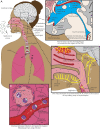Neurology and the COVID-19 Pandemic: Gathering Data for an Informed Response
- PMID: 33842072
- PMCID: PMC8032425
- DOI: 10.1212/CPJ.0000000000000908
Neurology and the COVID-19 Pandemic: Gathering Data for an Informed Response
Abstract
Purpose of review: The current coronavirus disease 2019 (COVID-19) pandemic caused by the severe acute respiratory syndrome coronavirus 2 (SARS-CoV-2) is one of the greatest medical crises faced by our current generation of health care providers. Although much remains to be learned about the pathophysiology of SARS-CoV-2, there is both historical precedent from other coronaviruses and a growing number of case reports and series that point to neurologic consequences of COVID-19.
Recent findings: Olfactory/taste disturbances and increased risk of strokes and encephalopathies have emerged as potential consequences of COVID-19 infection. Evidence regarding whether these sequelae result indirectly from systemic infection or directly from neuroinvasion by SARS-CoV-2 is emerging.
Summary: This review summarizes the current understanding of SARS-CoV-2 placed in context with our knowledge of other human coronaviruses. Evidence and data regarding neurologic sequelae of COVID-19 and the neuroinvasive potential of human coronaviruses are provided along with a summary of patient registries of interest to the Neurology community.
© 2020 American Academy of Neurology.
Figures


References
Publication types
Grants and funding
LinkOut - more resources
Full Text Sources
Research Materials
Miscellaneous
